|
(Updated 9 August 2007)
Welcome!
Have fun!
The great Transtibetan Railway tour 9 - 29 July 2007.
After having done quite a bit of travel lately and realising that it was/is quite an expensive hobby (especially whilst on non-paid sabbatical) I decided to spend that extra money on a real adventure trip. A trip to China, Tibet and Nepal! Start in Beijing, train ride to Lhasa on the world's highest railway and from there by Landcruiser to Mount Everst Base Camp and Nepal before finally flying back via Dehli. As you may see from the Landcruiser element, this is not the grand exhausting by foot trekking tour, it is rather something closer to the lazy, fat man's tour of the Himalaya! :-)
Here is my day-to-day travel log, including pictures. The availability of internet facilities on location was, no surprise, not the best, which is why the update has been slightly delayed. I hope you'll enjoy reading it as much as I enjoyed writing it.
Prolog:
The weekend of 6-8 July, I went to Rome with 15 friends, some of whom I had not seen for a year. Rome showed itself from its best side that weekend. My direct flight with SAS got canceled and I was rerouted via Budapest and got to Rome in the evening instead of noonish. For the first time ever in all my years of travel, my luggage did not arrive in Rome at the same time as I did – it arrived fairly late on Saturday. Pretty much in time for Sunday check out. Sunday, after the magnificent Ferrari win at Silverstone, I flew back to Copenhagen to get ready for the Monday departure from Copenhagen airport. Managed to get upgraded to a Business Class room at the Hotel Scandinavia for the night. The room came with a lot of freebees that I unfortunately had no time to enjoy. The breakfast buffet was – as always – delicious.
Day 1:
Meeting time in Terminal 2 of Copenhagen Airport is 13:15 hrs in front of the Karen Blixen Cafe. Very fitting choice of venue for a meeting point for travellers indeed. I stopped at the new Starbucks in Terminal 3 for a few cups of Java before heading to Terminal 2 and the meeting point. Once at the meeting point, a white sign on a suitcase with the name of the tour operator indicates the meeting point. Our Danish tour guide, Mathias, is a 24 year old son of a diplomat. From the age of two he lived 16 years in China and is fairly fluent in Chinese. He masters a decent British English after graduate studies in London. One by one, or rather two by two the other tour members arrive. Out of 16 travellers, only 4 are not pairs. Most turn out to be school teachers with myself, a banker and a retired couple not being part of the school teacher community. Ten year old Michael, who is travelling with his mother, and myself are pulling down the average age of the group. We have our own group check in desk and are soon on the Air France flight en route to Paris and from there to Beijing with arrival the next day Beijing time
Day 2:
We arrive late morning at Beijing International Airport. My luggage arrives, however, not without being damaged again. This time one of the other group members is the unlucky owner of a lost piece of luggage and we wait for her filing a claim form. Once outside, our Chinese guide, Mr. Yang, awaits us and shows us to the bus that will take us to our hotel in Beijing, the Ping An Fu Hotel. The hotel is a decent three star hotel. My room is on the fourth floor and the hotel does not have a lift! After check in, we depart for our first sightseeing in Beijing, the Lama Temple. Not a place of spitting Lamas, neither the four legged version nor the likes of Frank Rijkard, Rudi Völler or Francesco Totti. This is the most famous Buddhist temple outside Tibet. Dinner is served at the hotel early that evening as everybody is tired after the flight and the walking around in the afternoon. A 1.2 litre pitcher of beer is a little less than USD 3! After a good meal and some good beer, I eventually find myself sleeping in my comfortable bed by 20:30 hrs.!
Day 3:
I wake up early and find myself at the breakfast buffet as the first this morning. It’s 7 AM. The breakfast buffet is not like at the Hotel Scandinavia but still not bad. I find myself thinking about how to keep updated on the Man Utd tour of Asia? What about the signing of Carlos Tevez? What about Michael Laudrup’s move to Getafe? Which all means: is there any reliable internet connection here? Turns out there is at the hotel, however, only one computer at the business center. The bus departs at 9:15 for today’s sightseeing tour. On the program that day is Coal Mountain, the Forbidden City, Tiananmen Square and a Kung Fu show, which happens to take place in a place called Red Theatre! A visit to a silk factory is also on today’s agenda. At lunch, a 0.6 liter beer is a little less than USD 1.40! Our guide, Mathias, tells us that there is an issue with the train tickets to Lhasa. The ticketing system is government owned and controlled and even though tickets are on sale ca. 10 days before departure, not all tickets go on sale at once. Seems the good old system of more than good contacts on the inside is the name of the game here too. We have 13 tickets for Saturday, which is a day later than programmed. The last four tickets are being pursued, however, we may end up getting those tickets for a Friday departure. A draw is made and I end up in the potential Friday departure group. Back at the hotel, the internet works enough for me to read that Michael Laudrup has signed with Getafe and the Tevez transfer is being blocked by the Hammers. Beer prices at the hotel bar are double of those in the hotel restaurant!
Day 4:
Weather is foggy today. Yesterday was a cloudless sky with bright sunshine but today is not that nice. Today is the day of the Great Wall. The only man made construction visible from space. Only recently has it gotten some competition from the “Palm” in Dubai. There are quite many stairs to climb to get up on the wall. A cable car takes us up to a platform from where fairly easy access is to the Wall. Mathias tells us that the official opening ceremony for the Danish Olympic delegation at next years Olympic Games will be held at this platform. Mathias brought a magnum bottle of Chinese champagne which we share in the nearest tower on the Wall. On the way down street vendors are fighting for our attention offering all their souvenirs at one dollar a piece. The final asking price somehow is a lot higher once you get wheeled in. That’s when your negotiation skills come to the test. Lunch today is .. no, not Chinese ... Subway! When Subway was the only surviving place in the Foodcourt at Forum in Costa Rica, it was a bit boring after a few days. Now it is actually a bit of a feast! We also visit the Ming Tombs and the Spirit Way, which is a 7 km long road leading up to the Tombs. The Ming Tombs are the final resting place of 13 of 16 Ming emperors. When you hear Ming you instantly think of Ming vases. After a visit to a Ming vase factory, I can now reveal that the vases are not at all made of porcelain! They are in fact made of metal! So all films you’ve watched where a Ming vase is broken into thousands pieces are more fictional than you’d imagine! In the evening we visit a place that is one long bar street by a lake.
Day 5:
Friday morning! I pack my luggage in case I have to leave on the train to Lhasa today together with three of the other members of our group. The weather is still foggy. Difficult to tell if smog also is the reason. After all, Beijing is a city of approx. 15 million people and way too many cars. Our bus leaves the hotel and takes us out into the chaos called traffic! It’s is quite similar to other old communist countries like Russia where the road system was built to the comfort of the privileged and now serves the masses with the number of cars to drive the same old road system being more than 100 fold now. Our bus driver seems to posses that famous driver gene with a good mixture of patience and aggressiveness enabling him to get us safely and efficiently to our goal. This morning we drive out to the Summer Palace, which is a beautiful place with the long corridor and the lake. Later, we drive to the Olympic village, which is still under construction for the 2008 Olympic Games in Beijing. From the progress till today, you have to wonder whether they will be able to have it all finished before the opening of the Games? The new constructions, including the Olympic Stadium, The Bird’s Nest, are situated opposite the old village used when Beijing hosted the Asian Games in 1992. Upon request, Mathias shows some of us a DVD shop. The lady in the shop would not recommend the most recent films as they were not good copies. Ah .. service as in the old days at my favourite video shop in Moscow! I still end up buying four films – all excellent quality – at approx. USD 1.40 each. Next on the agenda is a visit to the Underground City, which is a network of long corridors and tunnels underneath the city with access to many stratetic venues throughout the city itself. It was last used in 1989 to get police and military quickly to Tiananmen Square. Upon arrival, we are told that only part of the place is partly open to the public only. The open part quickly leads to a silk shop where they expect you to buy a lot. A little contribution to some special fund also seems to open doors in this country and instead of cruising the silk shop we are shown the rest of the underground area!We end the aftrernoon at Beijing’s famous Pearl Market, which seems to be more of interest amongst the women. Still no news on the train ticket front! In the evening we went to a Chinese (!) restaurant not far from our hotel. We were practically the only guests in the restaurant. I believe they were not used to invading Vikings as they were quite amazed by our beer consumption! The Oktoberfest might give them heart attacks! Young Michael is charming the heads off all the waitresses. I believe we men all agree what a wonderful world it would be having his skills and our knowledge!
Day 6:
Saturday morning! Pack again and check out. The bus departs at 8:45 for our last sightseeing in Beijing. Today is the last day in Beijing and there’s still no news on the train ticket front! I believe all our minds are filled with concerns about the tickets whilst we spent the morning at a big Chinese flee market, which also has international shipping service should your newly acquired Buddha statue not fit into your luggage. At 11:30 the waiting time is over! There are tickets for all 17 of us and we are all on the same train train departing 21:30 tonight! Big round of applause from all! The rest of the day is somehow a lot more relaxed. We head down to what probably can be called a typical expat supermarket in the embassy quarter. I buy some bread, Danish cheese and lots of water as well as a bottle of Australian red wine for the train ride. The train station from which we are departing is huge and looks more like a space station (with a typical Chinese roof) than a train station. We are on the T27 to Lhasa. Our compartment is a socalled hard sleeper with 6 beds. Four of us from our Danish group are in the compartment sharing it with a Korean man and a young Chinese lady, who is heading back to Lhasa to visit her parents who live and work there. Her name is Andie. We do not really see much of the Korean man as he is travelling with a big group all located in the next compartments. There are toilets at the end of each train. The need to visit them in the middle of the night is not that great.
Day 7:
I wake up at 5:15 and make my way to the toilet before everybody else gets up and block the place. By 6:00 almost everybody is up and very noisy. The weather today is very bad. Very foggy. Probably the worst weather on the tour so far. The train ride from Beijing to Lhasa takes 48 hours and covers a distance of over 4.600 km. It takes you to its highest point at the Tanggula Pass, which makes it the highest railway in the World. The train opened in July 2006 and is carrying a lot of (wealthy) Chinese to Tibet now. The Chinese plan to extending the tracks all the way through Tibet to Nepal. That would undoubtedly make the tour more popular but still leave issues open around the ticketing system, in my humble view. In the early morning, we make a longer stop in Xian. The train also has a restaurant and we head down there for breakfast. The breakfast is probably the closest we have gotten to a more western style breakfast on the tour so far. Judging from the Chinese breakfast menu being served, we are fairly happy with our servings. The coffee is also fairly decent and we end up having a few refills hereof. There isn’t that much to do on a 48 hour train ride other than watch the landscape passing by outside the windows. And drink plenty of water. Due to the altitude, drinking water is important. The air does not contain as much oxygen as we have been used to. Though one could say that the air in Beijing probably is fairly low on oxygen and high on other exhaustion gases! The train has oxygen supply available and special oxygen outlets dispens oxygen once the train is above 2800 m above sea level. The oxygen level in the train is kept at the equivalent level of 2800 m altitude. It does not seem to work too well in our part of the train as we all have issues with shortness of breath. In the afternoon we go back to the restaurant train and have few beer. Theysell Budweiser only. Not the Czech but the American. Mathias tells us about one of the other groups travelling same route as us but 4-5 days ahead of us. Three of the guests had severe altitude sickness issues and had to be transported back home to Denmark. Everybody in our group still seem to be doing fine though I hear some have started taking medication for altitude sickness. That evening, I have a minor headache. Then I remember the three beers earlier and realise that I probably do not have altitude sickness! Andie has decided to show off her singing skills. Apparently, it is supposed to be polite to sing too. Almost similar to Russian vodka toasts. I try to remember some of the “cleaner” lyrics in my repertoire. At 21:00 hrs the altitude meter in the train shows 3200 m.
Day 8:
Breakfast at 7:30. The altitude meter shows now 4561 m. We can see the first snow top mountains as the train makes it way through the Tibetan plateau and the wild life it has, Tibetan gazelles, wild horses and yaks. By 9:30, the meter reads 4700 m and by lunchtime we are at the Tanggula Pass at 5072 m, It is quite a spectacular scenery and yet I am already looking forward to a cosy and comfortable hotel room and bed. Only a few hours left. By 14:15, we pass the highest freshwater lake in the World. Quite a bit more than the 173 m, which is the highest natural point in Denmark! New trin guests have embarked the train and bought the seats in the train restaurant, alas, no lunch or dinner today. At 20:00 we arrive at Lhasa train station where we are met by our Tibet guide, Rinchen, who is Nepalese. We get on the bus that takes us to our hotel in Lhasa, the Dhood Gu Hotel, which is located in the center. My room is on the third floor. Again, the hotel has no lift. We have dinner in the hotel at 22:00. The food is Indian style food, which means a good curry. The local beer is Lhasa beer, which is owned by Carlsberg!
Day 9:
First day in Lhasa, the forbidden city in Tibet, home of Buddhism and the Dalai Lama – well, used to be. The current Dalai Lama, the 14th, is living in India. After the Chinese invasion of Tibet in 1950, the Dalai Lama fled Tibet. No picture is seen of him in Tibet or China. The agenda for the day is a visit to the Jokhang temple, which is located in the very centre of Lhasa with the market surrounding the temple. Pilgrims come to the Jokhang temple from far away. We saw some walking through the Tibetan Plateau on our train ride to Lhasa. Some pilgrims walk for two years or more before they arrive in Lhasa for their target. In the afternoon we visit the Potala Palace, which stands as one of the most famous Buddhist constructions. It served as the residence of the Dalai Lama. With the most recent living in India, it is being used by Buddhist monks. The Potala Palace is an impressive building and with 13 storeys is the highest building in Lhasa situated on top of a hill and with lots of stairs! The Chinese are building high rise buildings in Lhasa that may soon compete with the height of the Potala Palace. At dinner in the evening I try my first yak steak. Not bad at all. The meat structure is a bit different than beef but still quite tasty and goes down well together with a Lhasa beer!
Day 10:
Today we have the morning on our own until 13:00. I locate the “business centre” of the hotel. There are two computers with internet access. Again the access is not that great and I only barely manage to get online to see that Michael Laudrup was already presented in Getafe on 9 July and Carlos Tevez is still not a Reds player. I then decide together with some others to find an ATM as I am a bit short on cash. Cash does not seem to be that readily available in Lhasa. The first two branches of Bank of China are out of cash. After a longer walk in the burning morning sun, we finally find an ATM with cash. In the afternoon the bus takes us to a nunnery. The nuns living here are from the age of 21 to 65 years. Their haircuts are quite similar to mine. Later we drive to the Sera monastery, which serves both as highly developed monastery and university for the monks. At its peak approx. 5000 monks lived here. In the afternoon, the monks have a debate in the garden. This is part of their training and needs to be experienced. The monks seem to be enjoying it judging from their smiles. In the evening we have dinner at a restaurant with both a Chinese and a Nepalese buffet. The latter seems to be the favourite. The restaurant also features a traditional Tibetan show with colourful costumes.
Day 11:
I was raining heavily all night with quite some thunder. This morning is departure from Lhasa. I had read that most barber shops in Lhasa were actually fronts for other professional services. I just never found them. There was a barber shop in the same street as our hotel. I noticed it was closed already at 20:00, so it must have been a genuine barber shop. Others has been walking around the city and found a street with a row of barber shop where it was more obvious that other services were offered there. We head out in five Toyota Landcruisers. We are four in our Toyota, three Danish tourists and our Tibetan driver, who turned out to be an excellent driver. Our drive takes us out one Friendship Highway. Highway and highway, well two thirds is bumpy dust road. The weather is quite bad today and when we stop to admire the Yamdrok Tso Lake at ca. 4800 m, we cannot even see the water in the lake because of the heavy fog. We arrive in our next stop, Gyantse, Tibet’s fourth largest city, at 20:00. My hotel room is nice and big. From the restaurant on the fourth floor (no lift) you can see the fort, which was used in the battle against the British some hundred years ago.
Day 12:
The morning is fairly cold. We are now on our agenda where we only have one night at each hotel and we have checked out this morning are ready to drive to Shigatse, which is the second largest city in Tibet. Before we leave Gyantse, we visit the local horse race festival, which is quite an experience. I don’t even miss the good old CIS when we are being asked to pay entrance fee. Something they only seem to be asking from us round eyed tourists. We arrive in Shigatse at 17:00 and find out that despite having booked the rooms more than one month ago and received con formation of the booking, we are three rooms short. Some military officials have decided to stay Shigatse whilst visiting the horse race festival in Gyantse! Our Danish guide, Mathias and three others stay at a different hotel for the night due to this. When we meet for dinner that evening they tell us that they have all the things at their hotel that our hotel seems to be missing: lifts, hot water and some other minor facilities. We go out for dinner at a Nepalese restaurant. Our Nepalese guide, Rinchen sure knows where to find good restaurants. Dinner is excellent and our waiter is wearing a genuine Man Utd shirt. It is the last Vodafone season edition.
Day 13:
Yet another chilly, rainy morning. According to the official program we are supposed to have our next stop in small town called Shegar., which allegedly is not that exciting a place. It is therefore suggested to skip that town and head directly to Tingri the next stop hereafter. It is unanimously decided to follow the suggested route. Before leaving Shigatse, we visit the Tashilunpo monastery, which today is one of Tibet’s most active monasteries. It used to be the main place for the Panchen Lama, the second highest incarnation of Tibet. Where the Dalai Lama is the religious leader, the Panchen Lama is more a political leader, a sort of a counsellor to the Dalai Lama. We also visit a market in Shigatse before driving off to Tingri. The hotel/motel here is probably the poorest standard on this trip so far. It is fairly cold here, especially at night. In addition to that the hotel shuts off the power at night – and most of the time when the kitchen is closed, so we discover next day! It makes finding the toilet at night somewhat of a challenge.
Day 14:
After a night of freezing and sore feet after bumping into some of the furniture in the room in the darkness of night time, I welcome the return of the power and hot water at 6:45. Tingri is at 4390 m. Back to our original program. We were supposed to stay one night at the Rongbuk monastery just a few km before Everest Base Camp. The monastery is located at above 5000 m. Should anybody fall ill during night there, it would be a four hour drive down to the nearest decent medical facility on roads that are practically non-existing. Once again, there is consensus to change the program. The plan now is therefore to drive directly to Everest Base Camp and then head straight down to the Nepalese border. The hotel facilities at the Rongbuk monastery apparently do not have such elementary facilities as water or electricity and the night time temperatures are around 0 degrees Celsius. After two nights at Tingri without hot water and electricity and cold night temperatures, we all seem to be of the same opinion that a third night under these conditions at a higher altitude is something we should be able to live without. Yes, we end up spending another night here! The weather is quite bad. It is raining heavily, especially up in the mountains. On our ride to Everest Base Camp we apparently have to cross a river – and it’s not over a bridge! Another Danish group has waited for two days now in Tingri for the weather to get better. A smaller Australian group has waited for three days and are giving up now. No visit to Everest Base Camp for them. It is still a cold and rainy morning and we are waiting for the weather to clear up. Will we go to Everest Base Camp this afternoon or do we have to wait till tomorrow? We pass time by playing cards. Texas Hold’em. We use the hotel’s roasted peanuts as chips. As usual I am out fairly quickly. We are told that the last 30 km before the Nepalese border is one big roadwork, including a few dynamite explosions along the road too. Once again a minor change to the plan. It would probably be best to stay the night in the city before the border and await the status of the roadwork in the early morning and head out whilst the work is on hold or preferable before the day’s work starts. A German group also waiting had sent a driver up to check the water and the flooding. They have now decided to head straight to Nepal. A Danish group just returned from an attempt to get to Everest Base Camp but had to return due to the bad weather. We are not going today, that should be definite now. We leave tomorrow morning. Some of us take as troll in the city and discover that we probably are staying at the best hotel in town! More card playing is on the agenda for the evening and a few Lhasa beer.
Day 15:
Last night in this cold, dark room. Like a clockwork the power is back on at 6:45. And we are off to Mount Everest! As we make our way through the rough Tibetan landscape, asphalt road turns in to bumpy stone road and in to sandy dirt road and something that is covered by rain water with a fairly strong current. We cross the river in good old western style. The water is fairly deep but that is no problem for our Toyotas. Some Japanese tourists in a mini van with Chinese guides get stuck in the middle of the river. Quite a view when one of them climbs out of the window and on top of the van! They eventually are pulled out of the river and we leave them and continue our quest. We arrive at Rongbuk Monastery, which is ca. eight km from Everest Base Camp, at noon. The next six km our cars can drive. The last two km no cars are allowed. Here you can chose to walk or you can pay 50 yuan (approx. USD 7) for a horse (pony) carriage ride up and down. We arrive at Everest Base Camp (Tibetan side) which is at 5300 m. From here many trekking and climbing tours start. Well actually this is merely the touristic base camp. The professional base camp is a little higher up and requires a fee of USD 200. We stop here and enjoy the cheaper view. The weather has started to clear up a bit and once we got the 5300 m high base camp, the clouds pulled aside and showed the Mount Everest summit in clear sunshine! One hour later it closed again and we headed back to our transportation. Our guides and drivers asked us what we had had for breakfast and to what Gods we had been praying. They had never experienced a group with such luck bearing in mind the other groups’ disappointing meetings with the mountain the last few days. We tried to explain to them the wonders and powers of the Viking Gods! Sometime late that evening, satisfied with what we had seen, we arrived in Nyalam, the city just before the roadwork. The hotel was more of a hostel and I ended up in a three bed room. We were all to tired after the long drive that day and slept quite well. Toilets down the hall way but fairly close to the room, which was on the third floor – no lifts here either.
Day 16:
We are up early to ensure that we can drive the last 30 km to Nepal before the roadwork starts today. It’s raining, which means that they’ll likely not start work too early today. We have two cartons of cigarettes for the road workers, just in case. We have heard stories of people being held up for days before they could pass. We manage to get on the road immediately. No work seems to have started yet. The road, which is more of a rock path on the side of the mountain that a road is only drivable at a very low speed. We manage to slip through without problems (minus two cartons of cigarettes now being enjoyed by some road workers. The road takes us down, down, down. Some 300 0 m within few hours till we reach the border town of Zhangmu, which is at ca. 2000 km. We were supposed to have spent the night in Zhangmu but due to the road works we changed our program a bit and now aim for arrival in Kathmandu a day earlier. Our hotel in Kathmandu is a five star hotel so everybody is more than looking forward to that after the 1000 km of bumpy car ride through Tibet. The border is an experience in itself. After Zhangmu, there’s a long drive through no-man’s land. We then walk across the Friendship Bridge and check in to Nepal. On the Nepalese side, our bus is waiting to drive us to Kathmandu and the five star Malla Hotel. The hotel stars should be awarded for quality, not just the availability of certain facilities. Those available at the Malla were unfortunately not working all too well compared to usual international standards. Though it was still a pleasant change of scenery compared to the cold and primitive quarters we had in Tibet the last few days. Dinner that evening is Kilroy’s. This is our first awareness
Day 17:
First day in Kathmandu and waking up in a very comfortable bed in a five star hotel. In China and Tibet the hotel only had Chinese TV channels. In Kathmandu, there’s also the typical international news channels as well as sports and film channels. All in English and one in German. The breakfast buffet is decent too. Quite a bit more international than our recent Tibetan experiences. The guided tour of the city is one the agenda for today. Kathmandu is a fascinating city with its mixture of Hindu and Buddhist sites and the Royal Palace and especially the market places in the very narrow streets. The streets where cars and motorcycles drive alongside rickshaw and bicycles frequently using their horns and bells to alert walking tourists. At first, it sounds quite annoying and irritating. After a while you get used and it is merely part of the charm of walking the streets of Kathmandu. We have dinner in the evening at a restaurant called Big Belly. Needless to say, decent size portions and Tuborg 0.6 litre beer!
Day 18:
Today is free for own exploring and most people head out to check the shopping opportunities. We have dinner at the hotel in the evening, which was not that great an experience. Though they have Tuborg.
Day 19:
Another quiet day in Kathmandu. I have decided to buy a Tibetan wooden mask and walk the markets to find one. Most are okay, but none really have the wow factor. Those I have found so far that could work are a bit to big for my taste. Finally find a place where I buy one. The shop was located on second floor but the entrance was through the backyard of the building. A key to the door was sent down tied to a string and a very steep staircase led up to the second floor. Found the wow factor quite quickly there. Back at the hotel, I teach young Michael how to make cannonballs in the hotel pool. Last dinner in Kathmandu is at the Roadhouse Inn. And they have Tuborg! So does the Tom and Jerry Pub on the way back to the hotel. The music there was older than the average age of the guests.
Day 20:
Going home day. Our flight route back to Denmark is Kathmandu to Dehli, India, and then from there to Paris and then Paris to Copenhagen. Kathmandu to Dehli is with an airline called Sahara Air. In Dehli we change to Air France the rest of the way. In Kathmandu, we only get boarding passes to Dehli. In Dehli we apparently have to identify our luggage and then get boarding passes for the remaining flights. We end up waiting four hours in Dehli and the Air France guy manages to get our check in wrong and it has to be done all over again resulting in our being late for boarding. I somehow end up having a window seat from Paris to Copenhagen which was not what I ordered. My frequent flyer mileage was not recorded despite the guys saying they were. After returning I have also noticed that the mileage for the outbound trip to Beijing was not recorded either. Not sure if this is Air France or because we travel as a group?
Day 21:
We land in Copenhagen 9:30 and spread in different directions. It was quite an experience that I would recommend everybody to try. Sooner rather than later. With the speed of Chinese “development” in Tibet, who knows how long it will keep looking like now? Tibetans say that the development that has happened since 1990 is a lot more than the development in the last 500 years before that. The future development will undoubtedly involve more asphalted roads, more high rise housing, especially in Lhasa, more Chinese influence in farther regions of Tibet. There a some (western) films about Tibet and Tibetan culture that also could be of interest: Kundun, Seven years in Tibet, Little Buddha. Despite the Hollywood influence they are still good value.
|
Variety is the spice of life!

6 June 2-0 win in Riga

Saturday lunch in Rome
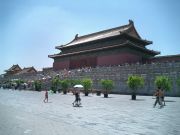
Forbidden City, Beijing
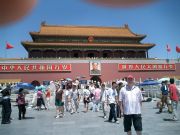
No introduction needed!
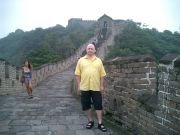
Viking man on the Wall

New friend on the Spirit Way

Train tickets have arrived!

Quality in everything they do!

On the train to the roof of the world
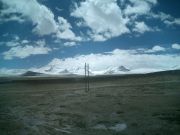
First signs of getting closer
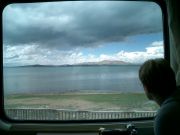
Next stop Lhasa

Lhasa city center and market

Pilgrims praying in front of the Jokhang temple in Lhasa
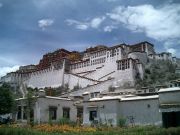
Potala Palace

We got a little ol' convoy
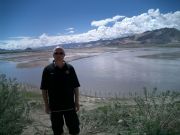
More romantic mood
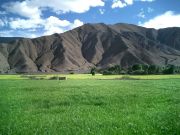
More roadside view

Buddhas in Gyantse temple

Horse race festival in Gyantse

Pass at almost 5000 m
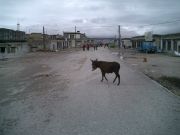
Tingri traffic

Probably not best strategy
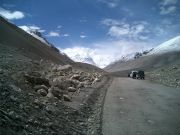
Getting closer to Everest

Viking man on top of the World

Mount Everest Summit

Buddhist Stupa

There's a virgin behind these doors

The streets of Kathmandu |